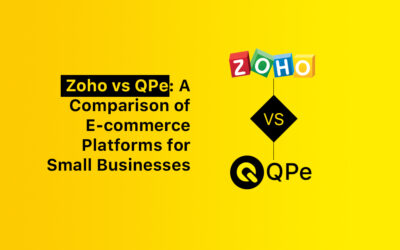More and more businesses are starting with dropshipping now! Online retail allows you to sell products without managing inventory or warehousing. As a middleman, you send products directly to your customers from your supplier.
Rather than managing inventory or warehouses, you sell, and your supplier ships. For beginners, it is a low-cost and easy way to get started.
Dropshipping is growing in India for a few reasons: the e-commerce market, the diverse audience, and government programs like Digital India make it easier to do business online. The best part? Suppliers can also be found on platforms like AliExpress and Meesho.
Though there are challenges like stiff competition and tricky logistics in rural areas, it is possible to make money from dropshipping. To start dropshipping well, you need a seamless e-commerce platform. We have QPe here.
QPe is a powerful e-commerce platform that empowers you to manage your online store easily.
Get your Free Trial or Book a Demo today and see how QPe can transform your online business! We will discuss this in more detail in this blog.
TL;DR – How To Start A Free Dropshipping Business
In case you want to take a quick look, here are the steps:
- Find a Dropshipping Supplier
- Research Your Niche
- Pick Your Products
- Choose a Platform
- Use Social Media
- Manage Your Store
- Set Up Your Store
- Build Your Brand
- Market Your Store
What is a Dropshipping Business In India?
Dropshipping in India is a smart way to run a business without keeping stock or handling deliveries.
Here’s how it works:
-You list products for sale, and when someone orders, you send the details to a supplier.
-The supplier packs and ships the item straight to your customer. You focus on selling. They handle the rest.
Why’s it catching on in India?
E-Commerce is growing rapidly. More people shop online every day, and cheap internet makes it easy for anyone to start. Plus, you don’t need to rent storage space or buy products in bulk.
That keeps your risk low. You can test different products, work from anywhere with Wi-Fi, and expand quickly by teaming up with new suppliers.
For Indian entrepreneurs, it’s a simple and flexible way to break into online business without spending a lot upfront.
Key Differences Between Dropshipping and Traditional E-Commerce
The following table compares dropshipping with traditional e-commerce so you can decide which is best for your business.
Factor |
Dropshipping |
Traditional E-Commerce |
| Stock Handling | You don’t keep any stock. Suppliers handle it. | You buy, store, and manage the stock yourself. |
| Starting Costs | Cheaper to start because no stock or storage is needed. | Costs more to start because you need to invest in stock and storage. |
| Profit Per Sale | You make less profit because suppliers charge higher prices. | You make more profit because you buy in bulk at lower prices. |
| Product Quality | Suppliers control quality, so you have less say. | You check the quality and have full control. |
| Shipping Control | Suppliers handle shipping, so you have little control over timelines. | You handle shipping yourself and can control the timing. |
| Branding | Limited branding; products usually come in generic packaging. | Full control over branding and packaging. |
| Customer Support | Resolving issues can take time since suppliers are involved. | You can quickly resolve issues directly with customers. |
| Growth Potential | Easy to grow because you don’t manage stock, but depends on suppliers. | Growth requires more stock, storage, and staff. |
| Competition | High competition; many sell the same products. | You can stand out by offering unique or custom products. |
| Risk | Low risk since you don’t invest in stock upfront. | Higher risk due to upfront investment in stock that may not sell. |
| Delivery Speed | Often slower because suppliers handle it, sometimes from far away. | Faster because you ship directly from your stock. |
This comparison can help you understand each system’s strengths and weaknesses. Your business’s goals, budget, and level of control can be taken into account when selecting an approach.
Step-By-Step Process: How To Start A Free Dropshipping Business
In nine steps, you’ll launch a store without spending a dime. Here we go.
1. Find a Dropshipping Supplier
Look for free supplier platforms like AliExpress or CJ Dropshipping. Pick suppliers with solid ratings and reliable delivery. Many of them offer free tools to sync products with your store. Just make sure there are no hidden fees.
2. Research Your Niche
Choose a niche that excites you and has steady demand. Free tools like Google Trends or AnswerThePublic can help you spot popular topics. Look for products that solve a problem or catch attention. Don’t dive into a niche flooded with competition.
3. Pick Your Products
Browse supplier catalogs for trending items that won’t break the bank. Prioritize products with good reviews and fast shipping. Go for unique or in-demand items. Skip anything that’s overly competitive.
4. Choose a Platform
Pick a platform that fits your budget and gets you started fast. QPe is a solid choice because it gives you a free plan or trial to test things out. No coding needed, no headaches.
You’ll find ready-to-use templates and integrations that actually work. QPe makes it easy to launch your store and kick off your dropshipping business without spending much but still aiming big.
5. Use Social Media
Social media is your best friend for free marketing. Share posts, stories, and videos on Instagram, or Facebook to grab attention. Join niche-related groups to connect with potential buyers. Don’t forget hashtags, they make you more discoverable.
6. Manage Your Store
Keep things running smoothly with free tools from your platform or supplier. Track inventory, process orders, and send updates to customers. Stay on top of feedback and fix problems quickly. It’s important to keep things simple here, do not overcomplicate things.
7. Set Up Your Store
Use free design tools or templates to create a clean and simple layout. Add sharp product images and clear, no-fluff descriptions. Test the checkout process to make sure it’s quick and smooth. Confused buyers won’t stick around.
8. Build Your Brand
You don’t need a big budget to create a memorable brand. Canva is great for making a free logo and graphics. Pick a name that sticks and stick to a color scheme that matches your vibe. A professional look builds trust.
9. Market Your Store
Use free strategies like collaborations, social media posts, or joining community groups. Share helpful content, like product tips or tutorials, to engage your audience. Try email marketing with free tools to stay in touch with potential buyers.
The key to dropshipping success is consistency and smart planning. Create a free setup, adapt as you learn, and grow your business.
How To Find Reliable Dropshipping Suppliers
The right dropshipping supplier can make or break your online business. Your brand will grow and trust will be built when you partner with a reliable company to deliver quality products on time to your customers.
Here are some simple steps to help you choose the right supplier:
Research Your Options
Use online directories, trade shows, and manufacturer websites to explore potential suppliers.
Reach Out to Suppliers
Contact your top picks and ask about their products, prices, and shipping terms.
Order Test Products
Request samples to check the quality of the products before committing.
Compare Quality and Pricing
Evaluate the test products and pricing to find the best value for your business.
Seal the Deal
Negotiate terms and finalize a contract that aligns with your goals.
A successful dropshipping business depends on choosing the right supplier. If you carefully consider your options, you’ll be able to succeed.
What Are The Profitable Dropshipping Business Ideas?
To find the right dropshipping niche for India, you need to learn what Indians love and match it with global trends. Let me break down a few ideas that are trending in 2024. Besides being hot globally, these are perfect for Indian audiences.
1. Beauty and Personal Care
People are going gaga on skincare and grooming these days. Things like makeup tools, niacinamide creams, or lightweight lip stains are super popular. Easy to market, easy to sell.
2. Health and Wellness
Everyone’s chasing health goals. Products like herbal teas, mushroom coffee, or even gummy vitamins (like beetroot ones) are making waves. It’s the “feel good” industry, and it’s booming.
3. Home and Living
Home décor is having a moment. Think floral patterns, cozy cushions, or brass accents. People love giving their homes a fresh vibe—especially during festivals or weddings.
4. Fashion and Accessories
This category always sells. Oversized hoodies, trendy bags, or casual sneakers are all safe bets. Pro tip? Keep an eye on Bollywood-inspired trends.
5. Pet Products
More people in India are adopting pets, which means grooming kits, cute toys, or even pet supplements are solid choices. Pet parents can’t resist!
6. Sustainable Products
Reusable bags, bamboo toothbrushes, or eco-friendly kitchen items are catching on. Many buyers, especially in cities, love products that help the planet.
7. Tech Accessories
Everyone’s glued to their phones and gadgets. Sleek phone cases, wireless chargers, or smartwatch straps? These are low-cost, high-demand options.
8. Kitchen Tools
Kitchen gadgets are fun and practical. Air fryers, spice organizers, or funky coffee makers are great. People love upgrading their cooking game.
9. Fitness Gear
Health is a priority, and it shows. Dumbbells, yoga mats, or weighted hula hoops are everywhere. Easy to ship, easy to sell.
10. Baby and Kids’ Products
Parents want the best for their kids. Safe toys, comfy baby clothes, or educational kits are always in demand. Think safety and quality here.
How to Pick the Best Niche
Make sure you don’t just jump into something because it’s trending. Take a look at the Indian market. Check out what people buy during festivals. Make sure you check regional habits. Choose products that won’t break during shipping and are easy to ship.
What’s the bonus?
You can build trust by offering quality over quantity. You’ll always win.
Conclusion:
Dropshipping in India sounds exciting, doesn’t it? Let’s be honest, it can be difficult to find reliable suppliers, run operations smoothly, and stand out in a crowded market.
With the right steps and tools, you can overcome these challenges. Identify a niche that excites you and has demand. Then, find suppliers who won’t let you down (no one likes late deliveries!).
Once that’s sorted, use social media to promote your store at a low cost. It’s free, and it works if you’re consistent.
Now, let me share something that makes life easier: QPe. It’s an all-in-one e-commerce platform that simplifies everything. You can create a good-looking online store, manage inventory, and even automate boring tasks like order updates and marketing.
No coding, no stress. Just pick a template, tweak it your way, and you’re good to go.
Want to see how it works? Book a demo or start a free trial with QPe today. You’ll have more time to grow your brand while QPe handles the tech stuff. Sound like a plan?
Frequently Asked Questions (FAQs):
-
Is Dropshipping Profitable In India?
Yes, dropshipping can be profitable in India due to the growing e-commerce market and low startup costs.
-
What Are Amazon Dropshipping Suppliers, And How To Find Them?
Amazon dropshipping suppliers are third-party vendors who provide products that sellers list on Amazon without holding inventory. To find them, explore platforms like Indiamart, TradeIndia, Meesho, and ExportersIndia.
-
How Does Amazon’s Dropshipping Business Work In India?
As part of Amazon’s dropshipping model, sellers list products on Amazon, and forward orders to suppliers, who ship directly to customers, while sellers handle customer service and returns.



